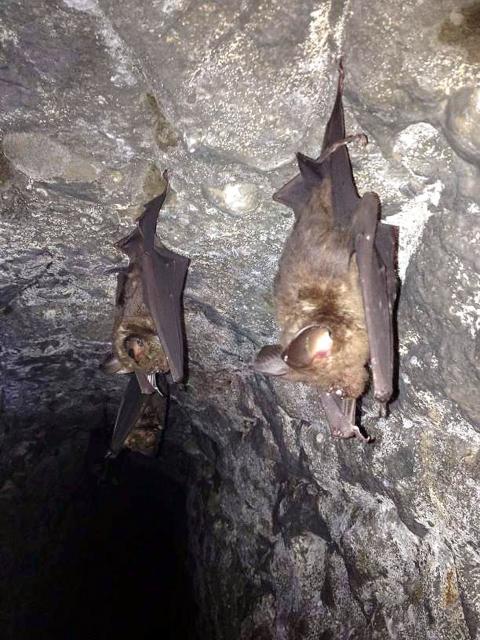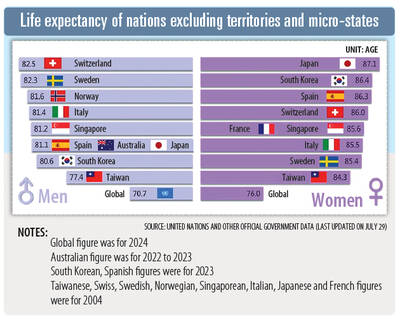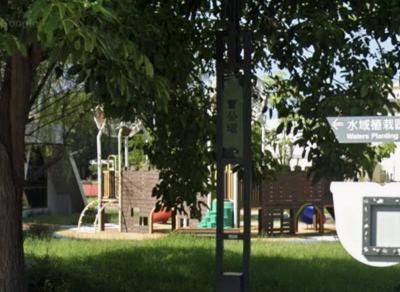Conservation groups and local residents in a hill area of Greater Taichung expressed delight that colonies of bats have returned after three decades of work on a cave that was once a famous attraction.
Civic organizations and municipal officials said that they are proud of the ecological preservation and conservation work that resulted in the reappearance of the bats at “Toubiankeng [頭汴坑] Bat Cave.”
The cave is in the Toubiankeng Leisure Agricultural Area in the Taiping District (太平), which is in the foothills of the Central Mountain Range.

Photo: Chen Chien-chih, Taipei Times
Repopulation of the Toubiankeng Bat Cave has left scientists elated, because the colonies consist of the Formosan leaf-nosed bat, Hipposideros terasensis, one of Taiwan’s endemic subspecies.
Much of the credit for the re-established colony goes to the Water Source Culture Foundation and its affiliated conservation groups in the city after decades of work.
On recent inspections, local volunteers found an estimated 100 to 200 bats inhabiting the cave.
The cave was dug in as part of an irrigation conduit to carry water from the area’s Dongbian River (東汴溪) to fields belonging to the local Lin (林) family.
Due to a severe flood in 1959, the river changed its course and the conduit dried up.
It was a blessing in disguise for wild creatures, as the conduit’s damp cave provided a suitable colony for the bats.
In the 1960s, the cave became a renowned tourist attraction.
“Those were the glory years for the site — the 1960s and 1970s. However, it ended when a big flood struck the area in the summer of 1983,” WSCF chairman Yeh Chin-yu (葉晉玉) said. “It inundated the cave and caused much destruction. After that, the bats went away and we have not seen them for the past 30 years.”
Yeh said after the 921 Earthquake, he led a working team in collaboration with the Toubiankeng community to initiate conservation programs in the area.
“We began by installing iron bar barriers across the cave’s entrance. The local tourism bureau laid pipes to draw a stream into the cave. After more than 10 years, we began to reap the rewards of our efforts,” he said.
“About two months ago, we observed several bats flying out of the cave to forage for food in the evening hours. Then last weekend, our team entered the cave with some local residents and were able to verify that there are about 100 to 200 Formosan leaf-nosed bats inside,” he added.
People going to the original cave entrance will not see any bats, as they are flying in and out of the grottoes through other entrances, he said.
“It was not easy for the bats to return, so we hope people will cherish them and not go into the cave and disturb the colonies,” he said, adding that people should become observers and protectors of wildlife, rather than behaving like tourists.
According to Yeh, talks are underway with local officials to set up a community patrol team to maintain the protective measures that have been established, while he asked people to leave the bats alone and allow them to flourish in their natural habitat.
Democratic Progressive Party (DPP) Legislator Ho Hsin-chun (何欣純) and DPP Taichung Councilor Huang Hsiu-chu (黃秀珠), were also involved in the conservation effort, having lobbied for funding to build a tourist bridge and other construction projects in the area.
“The bats returning is an auspicious omen for the people. I urge the public to watch the bats from outside the cave and not to enter it,” Huang said.
“Also, the Greater Taichung Government must implement security and protective measures. I will ensure that the bridge will be completed soon and together with the bats repopulating the cave, it should boost local tourism,” she added.
According to scientists, the Formosan leaf-nosed bat is the largest insectivorous bat in Taiwan, with its main diet consisting of beetles and other flying insects.
The cave-dwelling species normally weighs between 45g and 65g, with a wingspan of 54cm and can be found in habitats up to an elevation of 1,700m.

The inspection equipment and data transmission system for new robotic dogs that Taipei is planning to use for sidewalk patrols were developed by a Taiwanese company, the city’s New Construction Office said today, dismissing concerns that the China-made robots could pose a security risk. The city is bringing in smart robotic dogs to help with sidewalk inspections, Taipei Deputy Mayor Lee Ssu-chuan (李四川) said on Facebook. Equipped with a panoramic surveillance system, the robots would be able to automatically flag problems and easily navigate narrow sidewalks, making inspections faster and more accurate, Lee said. By collecting more accurate data, they would help Taipei

TAKING STOCK: The USMC is rebuilding a once-abandoned airfield in Palau to support large-scale ground operations as China’s missile range grows, Naval News reported The US Marine Corps (USMC) is considering new sites for stockpiling equipment in the West Pacific to harden military supply chains and enhance mobility across the Indo-Pacific region, US-based Naval News reported on Saturday. The proposed sites in Palau — one of Taiwan’s diplomatic allies — and Australia would enable a “rapid standup of stored equipment within a year” of the program’s approval, the report said, citing documents published by the USMC last month. In Palau, the service is rebuilding a formerly abandoned World War II-era airfield and establishing ancillary structures to support large-scale ground operations “as China’s missile range and magazine

STATS: Taiwan’s average life expectancy of 80.77 years was lower than that of Japan, Singapore and South Korea, but higher than in China, Malaysia and Indonesia Taiwan’s average life expectancy last year increased to 80.77 years, but was still not back to its pre-COVID-19 pandemic peak of 81.32 years in 2020, the Ministry of the Interior said yesterday. The average life expectancy last year increased the 0.54 years from 2023, the ministry said in a statement. For men and women, the average life expectancy last year was 77.42 years and 84.30 years respectively, up 0.48 years and 0.56 years from the previous year. Taiwan’s average life expectancy peaked at 81.32 years in 2020, as the nation was relatively unaffected by the pandemic that year. The metric

A 72-year-old man in Kaohsiung was sentenced to 40 days in jail after he was found having sex with a 67-year-old woman under a slide in a public park on Sunday afternoon. At 3pm on Sunday, a mother surnamed Liang (梁) was with her child at a neighborhood park when they found the man, surnamed Tsai (蔡), and woman, surnamed Huang (黃), underneath the slide. Liang took her child away from the scene, took photographs of the two and called the police, who arrived and arrested the couple. During questioning, Tsai told police that he had met Huang that day and offered to